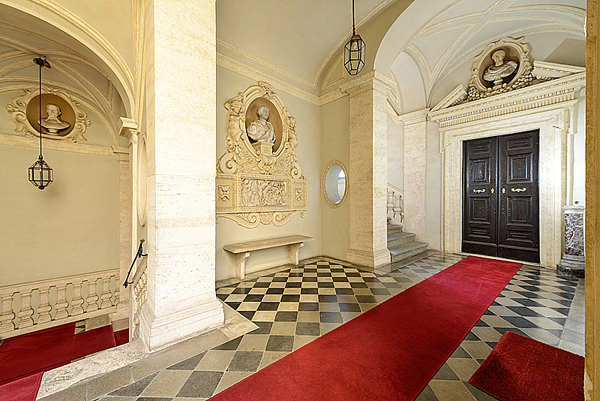Navona - Campo de' Fiori: "The Turtles Dream" apartment
The palace
The elegant Costaguti palace is one of Rome's finest, owned by a distinguished and courteous noble family since 1578. The palace overlooks two squares: Piazza Mattei, with the famous Turtle Fountain (Fontana delle Tartarughe), and Piazza Costaguti, named after the aristocratic family. Despite Piazza Costaguti is larger, the main entrance is in Piazza Mattei, near the Turtle Fountain.
The architects who designed and engineered the palace where: in the 16th century: Antonio De Battistis, Ascanio De Rossi, Carlo Franscesco Lambardi, and in the 19th century also renovations were made by Giovanni Battista Giovenale.
 |
 |
| Costaguti palace, entrance |
Costaguti palace, facade |
The section of the palace used privately by the Costaguti members to this day retains its original, famous masterpieces. It includes world-acclaimed frescoes by Romanelli, Cavalier d'Arpino (Caravaggio's maestro), Guercino, Domenichino, the Zuccari brothers, and Gaspard Poussin, among others. Of these large paintings, the most famous are perhaps the "Chariot of the Sun and of Time which discovers Truth" by Domenichino, and the "Hall of Venus" by Cavalier d'Arpino. Please visit the relevant page of the Piano Nobile and the family history.

|
 |
| A lamp in the palace court. Notice the coat of arms of the Costaguti family, even in the details (three sharpened lines pointing to three stars). |
| The palace stands on the ruins of an ancient Roman temple, and later of a church. The palace replaced both, and was purchased by the noble family Costaguti in 1578 from Costanzo Patrizi, the treasurer of Pope Paul III. The Costaguti, originally from Ligury (Italian Riviera) moved to Rome, where they became the treasurers of Pope Paul V during the 17th century. |
| (Left): beginning of the Palazzo grand staircase - the apartment has elevator, and there are no stairs to climb. |
|
 |
The "Turtles' Dream" apartment is endowed with elevator (you will not have to climb any steps!).
We recommend that at least once you climb the grand stairs of the Palazzo.
The left photo shows a landing with access to three apartments of the "piano nobile".
You can see that any detail is prepared with utmost care: columns, high-vaulted ceilings, capitals, steps, vases, lamps, tiles, doors, statues, bas-reliefs are impeccable.
The steps are also made of two types of marble: Carrara (from Tuscany), and Peperino from the Roman Castles (forming the steps to the right), which is now unobtainable, as it is not mined anymore. |
Opposite view of the grandstairs landing.
In this photo you can see more distinctly the statues of the ancestors (Ascanio and Prospero Costaguti), the marble bench in which they sat when climbing the stairs.
Renovation of every detail of the palace requires the authorization and supervision of the Italian Ministry of Cultural Resources. |
 |
All sides of the palace are interesting. One side faces the Jewish quarter, the fabled "Ghetto", loved by Romans and tourists alike.

|

|
| On one side of the palace, you find the charming Tempietto del Carmelo - Little Carmel Temple - dedicated to St. Mary of the Carmel, which is already situated inside the "Ghetto". |
The back of the Palazzo Costaguti, situated in the square with the same name (Piazza Costaguti). It has interesting gates with ashlar-work. |
The Costaguti ameliorated the palace through the ages. Originally bankers, they later embraced other professions. They also had two cardinals in their family. In the following centuries, they merged with another noble family, the Afan De Rivera, of Spanish-Neapolitan origin (they count a Spanish king, a Saint, and two Neapolitan viceroys in the ancestry), along with several generals. Please visit the page about the family history.

Internal court of the palace |

Internal court of the palace, with remainders of the old graffiti
(they must be preserved, by the law). |
The court inside the palace was recently renovated in order to recuperate the 16th century decorations. You find some classy cars of the owners parked (along with the unfailing Vespa). The coat of arms of the Costaguti family is everywhere. It displays three sharpened lines pointing towards three stars. The family in fact originated from the coastline of Ligury, in the Italian Riviera (Costa = coast, Aguta = sharp, in old Ligurian language).
|

